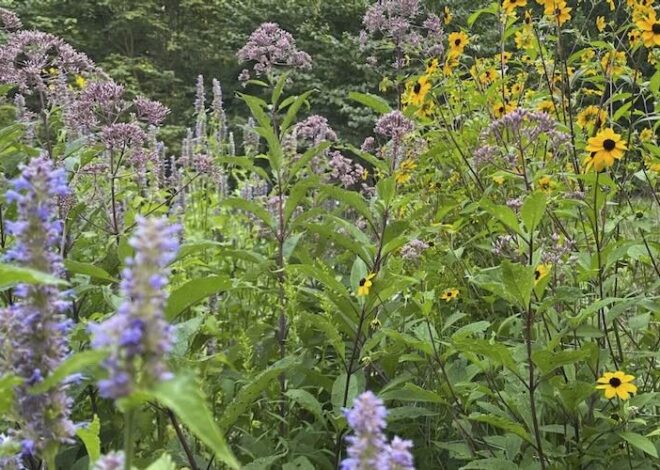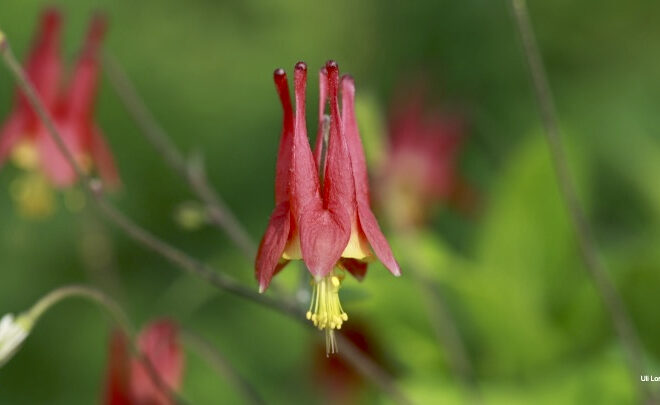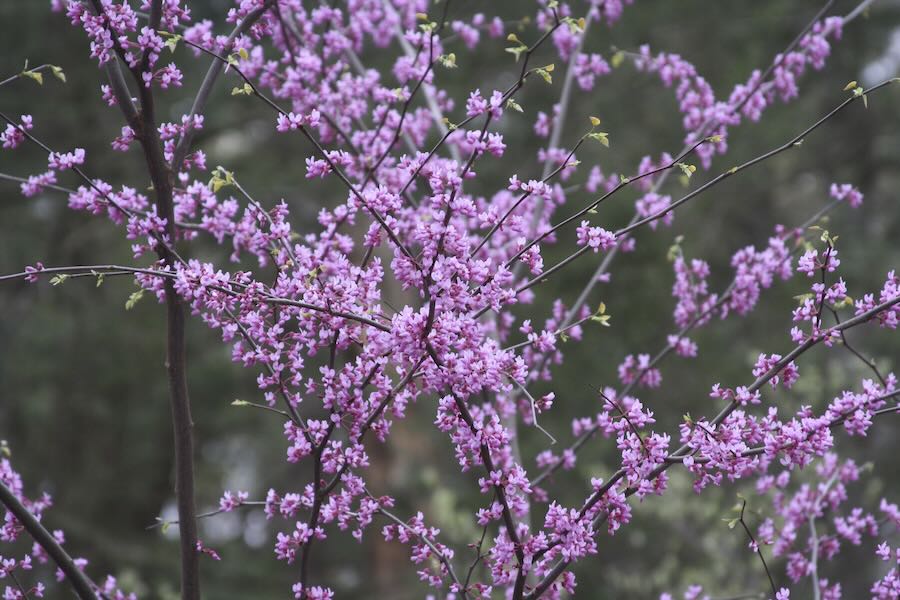
‘bio-productive gardens,’ with tim johnson of native plant perception
[ad_1]

 IN A RECENT cellphone identify, Tim Johnson used the phrase “bio-productive gardens,” and it stopped me.
IN A RECENT cellphone identify, Tim Johnson used the phrase “bio-productive gardens,” and it stopped me.
“What does he suggest by that?” I assumed.
After which he outlined: “There are strategies to deal with our landscapes,” he acknowledged, “so that the whole thing that flows via them, from rainwater to birds, leaves extra wholesome than when it arrived.”
“Inform me additional,” I replied. And so that’s my topic in the meanwhile with Tim, the model new chief of the longtime conservation group often called Native Plant Perception. We talked regarding the thought course of he’s making use of to creating his personal residence yard, and about better initiatives at work.
In January Tim grew to develop into chief authorities officer on the non-profit, which was based mostly almost 125 years previously as a result of the nation’s first plant conservation group and the one one solely centered on New England’s native vegetation. Tim, alongside together with his in depth background in environmental horticulture and natural science, simply these days led the Smith College Botanic Yard.
Study alongside as you’re taking heed to the March 18, 2024 model of my public-radio current and podcast using the participant below. You’ll subscribe to all future editions on Apple Podcasts (iTunes) or Spotify (and browse my archive of podcasts proper right here).
(Image of Cercis canadensis, or Jap redbud, above, from Native Plant Perception; portrait of Tim Johnson, below, by Sam Masinter.)

 ‘bio-productive gardens,’ with tim johnson
‘bio-productive gardens,’ with tim johnson
Margaret Roach: So new job. Getting acclimated? You’ve been I assume since what, late January, maybe, that you just’ve been inside the place?
Tim Johnson: New job, Week 7. And I do maintain saying though, I actually really feel a little bit of bit additional like I modified locations of labor than organizations. Native Plant Perception was an in depth companion after I used to be on the Botanic Yard, and it’s a crew that I’ve really appeared as a lot as and been fortunate to have in my expert group for just a few years.
Margaret: Yeah. Successfully, and as I acknowledged inside the introduction, Native Plant Perception, which was based mostly as New England Wild Flower Society almost 125 years previously, I really feel, is a conservation group centered on New England vegetation. Nevertheless for people who could not know, give us the … How do you describe it whilst you inform people what the kind of mission, what you’re doing there, what the emphasis is all these years later at this place that’s so historic?
Tim: Yeah, that’s an essential question. Native Plant Perception is an organization that is quite a bit additional dynamic than I understood from the floor. An essential functions are conservation, horticulture, and education, and we really work at a regional scale to satisfy all three of those departmental visions and missions.
So our conservation program does a considerable quantity of labor coordinating efforts all by means of a space, working with state, native, non-profit conservation professionals, along with group members. We do various work with most people on rare-species monitoring.
Our horticulture program works at Yard inside the Woods, nevertheless they’re moreover really influencing one of the simplest ways we yard and take into accounts landscapes all by means of the realm. After which our education program does a mix of in-person and digital, along with multi-educational functions that are happening at fully totally different web sites all by means of New England.
Margaret: So that you just acknowledged that the horticulture, various it’s centered at Yard inside the Woods, your sort of headquarters, is that-
Tim: That’s correct. Yard inside the Woods is taken into account one in all our properties. We even have Nasami Farm in Western Massachusetts, along with sanctuaries all by means of New England.
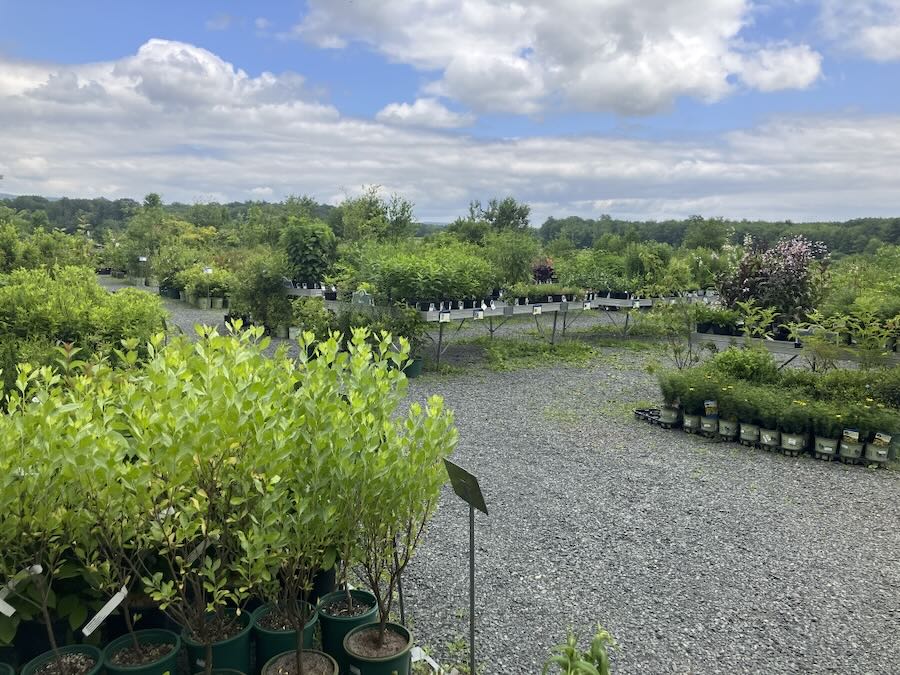
 Margaret: Correct. And it’s the cusp of spring. And for gardeners who’re inside attain of New England, or are going to be visiting the world or regardless of, I suggest, positively a trip spot, every Nasami Farm and Yard inside the Woods. And do you have to like to purchase native vegetation [laughter], it’s even a double trip spot. Not merely beautiful areas and areas to see these fantastic points, nevertheless plenty of nice … You’re propagating native vegetation and selling native vegetation, and so there’s masses to work together with is what I’m attempting to say. Ought to go to. Put it on the itemizing of ought to go to, correct? [Plants for sale at Nasami Farm, above; photo by Jane Roy Brown for Native Plant Trust.]
Margaret: Correct. And it’s the cusp of spring. And for gardeners who’re inside attain of New England, or are going to be visiting the world or regardless of, I suggest, positively a trip spot, every Nasami Farm and Yard inside the Woods. And do you have to like to purchase native vegetation [laughter], it’s even a double trip spot. Not merely beautiful areas and areas to see these fantastic points, nevertheless plenty of nice … You’re propagating native vegetation and selling native vegetation, and so there’s masses to work together with is what I’m attempting to say. Ought to go to. Put it on the itemizing of ought to go to, correct? [Plants for sale at Nasami Farm, above; photo by Jane Roy Brown for Native Plant Trust.]
Tim: Certain. And notably, we really try for the vegetation that we’re selling to return again from regionally tailor-made seed sources. And so our take even on seed product sales is a little bit of bit fully totally different because of reasonably than cloning vegetation, reasonably than working from cuttings, we’re attempting to be working from genetically-diverse populations.
Margaret: So, bio-productive gardens: You really threw me [laughter], as I acknowledged inside the introduction, I merely didn’t know the phrase. And so inform us what which means to you and why you sort of threw that out to me as one factor you wished to have on my radar.
Tim: I’ve to share the credit score rating for the thought with a colleague of mine, Dano Weisbord, who I labored with at Smith, and it received right here up inside the panorama master-planning course of that we co-chaired at Smith. And as soon as we now have been attempting to find out what is the widespread denominator for managing our panorama, and we had all these ideas about reducing fertilizer, reducing petroleum inputs, direct and indirect, attempting to basically create a healthful environment, we landed on this idea of bio-productive landscapes. And the idea, if we take into accounts our constructed panorama as an extension of nature, we really must be specializing within the ecological processes that are facilitated inside these landscapes that are in our metropolis and suburban environments.
Margaret: And so, one in all many things you acknowledged to me as soon as we talked the alternative day is that it’s the idea the whole thing that flows via them leaves extra wholesome, whether or not or not it’s water or a hen, as I acknowledged inside the introduction. So inform us a little bit of bit about examples of that, about what you will have, sort of, what’s in entrance of ideas if you’ll be a bio-productive landscaper or a gardener? What are the climate and the organisms that you have in ideas? Is it from microbes as a lot as mammals [laughter]? What’s-
Tim: Yeah, fully.
Margaret: Is it every dwelling organisms and belongings, so to speak, like rainwater?
Tim: Yeah, it is a holistic look regarding the abiotic and the biotic. And so an attention-grabbing issue, at least in my head as a gardener, occurred after I started to think about, “Successfully, can I yard in a fashion that’s bio-productive?” is I started to question the utilization of some standard practices. So as an example, would I be eager to utilize pesticides for points? Sometimes we face really, really troublesome points as gardeners. And I grew to develop into a lot much less and fewer eager to do this because of I didn’t like what it was going to do for the micro-communities; I didn’t like what it was going to do for water. I grew to develop into concerned about incidental damage, as an example, to honeybees and solitary bees visiting my yard. And so I completed doing that.
The other issue that I’ve really come to embrace with this system, with this … maybe it’s additional of a philosophy, is to basically work with what I’ve in my space. I am on a extremely, very sandy lot, it would not want to be a backyard. And if I try to carry it as a backyard, I’m going to want to place in various water. I’m going to want to place in various fertilizer and it’s going to be various backyard mowing as correctly to deal with it. However after I start to think about what want to be proper right here on this very sandy soil, I can start to work with the environment. And if I want to actually change it over the long term, I can herald nitrogen-fixing vegetation, I can start to slowly enrich the usual of the soil. And there as soon as extra, it’s enhancing reasonably than consuming the panorama that I’m gardening inside.
Margaret: Correct. So really then every step of the tactic—the plant palette, one other inputs, whether or not or not it’s, akin to you will have been merely saying, an insecticide or one factor like that, the utilization of any supplies that you just’d be sort of bringing in or any pure helpful useful resource—you’re really sort of figuring learn to do it in basically essentially the most useful and conservation-minded method. Is that-
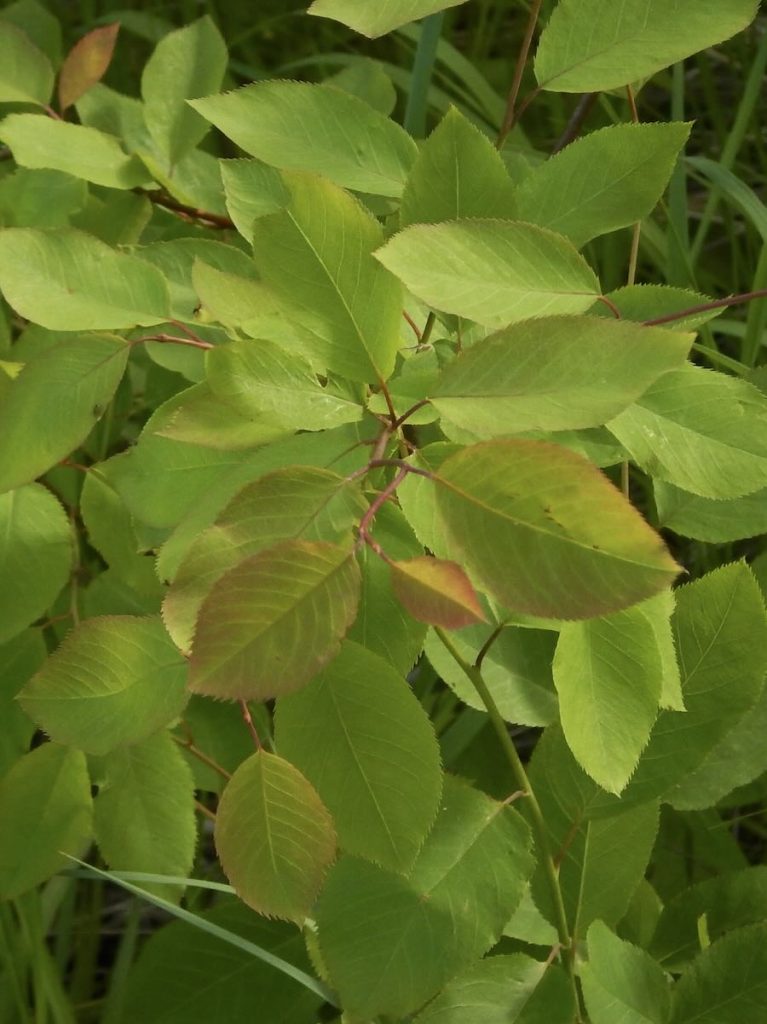

Tim: That’s correct. I really feel one in all many guidelines I’ve really come to embrace comes from restoration ecology, the place if we kind of check out what’s dysfunctional in a habitat, we would be able to actually deal with that after which have a far more autogenic yard. So as soon as extra, if I’ve very, very sandy soil and I’m putting in vegetation that mainly don’t need … If I’ve been to try to plant an apple orchard with my soil [laughter], it’s going to be pretty tough. I’m going to want to at all times fertilize it. To not level out we now have now points with fire blight and points like that.
Amelanchier grows somewhat properly proper right here, actually; it’s very fully glad. And so that’s moreover an edible fruit. And so contemplating far more dynamically. And even desirous concerning the devices that we’re using. And so forth the yard, transferring to electrical chainsaws, making certain that after we’re putting chain oil onto the observed, we’re capable of actually use cooking oil. We don’t should make use of petroleum-based oils on that. And embracing kind of this far more of a cradle-to-grave methodology of desirous about how we’re doing good with the yard.
For me, I take into accounts people transferring via my panorama and wanting them to actually really feel fully comfortable and know that they’ll eat meals afterwards, or they don’t have to worry about their kids strolling on the backyard or touching the vegetation, because of they’ll perception that they’ll be extra wholesome as soon as they step via it as correctly. [Above: Amelanchier bartramiana; below, the blooms of A. canadensis. Both by Liza Green for Native Plant Trust.]
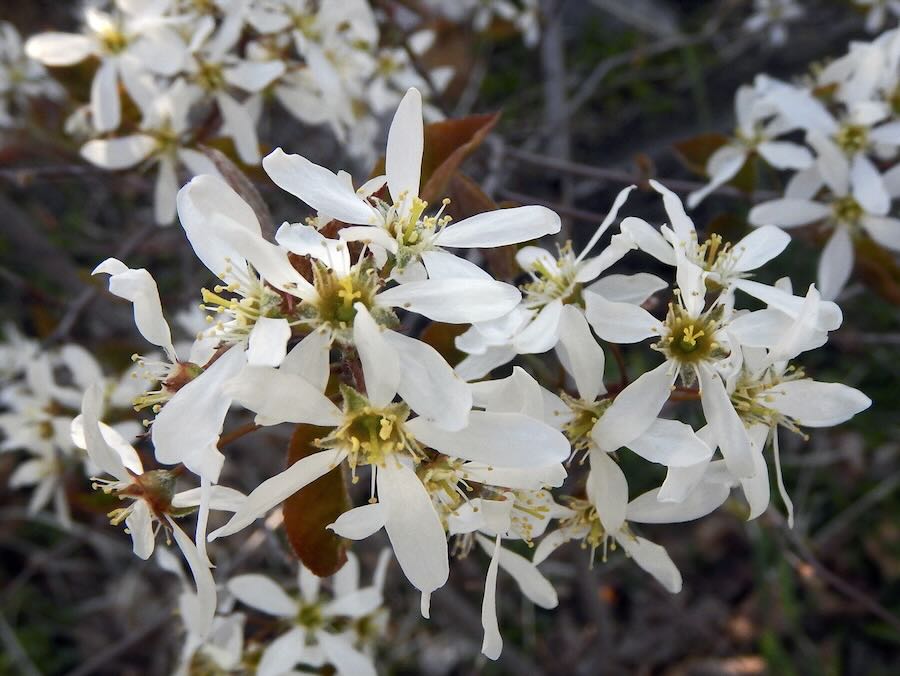
 Margaret: Correct. Now, you will have a sandy soil you acknowledged, and so the shadbush you will have been merely talking about, or what do all of them identify it moreover, serviceberry or juneberry?
Margaret: Correct. Now, you will have a sandy soil you acknowledged, and so the shadbush you will have been merely talking about, or what do all of them identify it moreover, serviceberry or juneberry?
Tim: Yup, serviceberry. Yup.
Margaret: Has so many different names, I really feel, correct [laughter]?
Tim: Correct.
Margaret: So that could be simply best for you larger than among the many larger fruits. And that’s an area plant, than an apple tree, an apple orchard or one factor like that. And so that you just’re doing evaluation on vegetation that are eager to develop, that are tailor-made to a sandy soil and so forth. And so that’s one part of it.
I sort of assume, and I’ve had just a few conversations simply these days with consultants in regardless of we want to identify ecological landscaping, or there’s so many different people use fully totally different language to elucidate it, and I identify it sort of “habitat-style gardening.” Are you visualizing for this yard of yours? Are you visualizing a habitat that you just’re … Are you conscious what I suggest? Are you mimicking one thing in nature in your sort of grasp plan or is it additional you’re searching for specific individual vegetation that may work? What’s the kind of better picture, or?
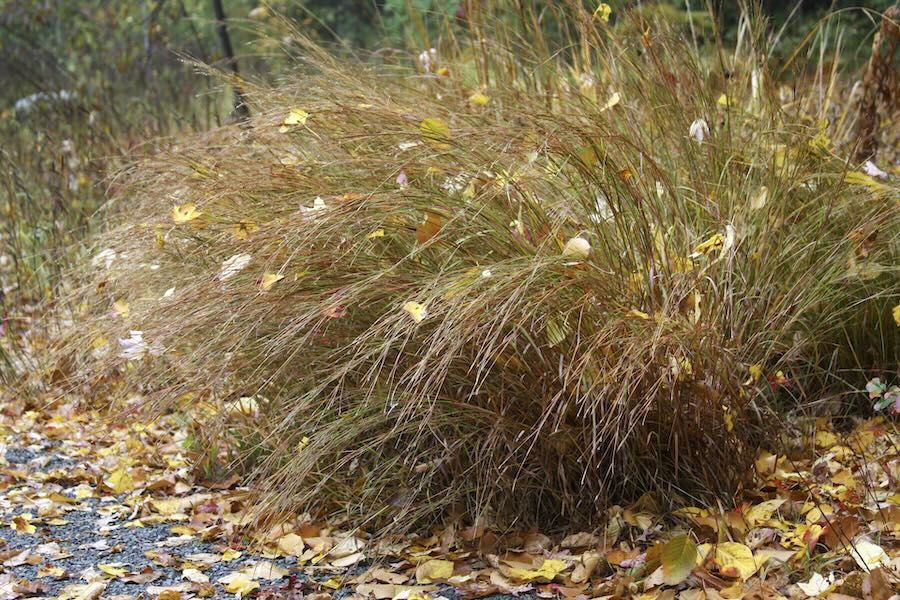
 Tim: Yeah, that’s an essential question. For me, my yard is a extremely sandy area. And so after I check out my panorama, an increasing number of I’m attempting to think about how I can create an aesthetic and helpful facsimile of this native habitat. I kind of have this idea that lastly my residence will get plunked into this sandy prairie, sandy grassland, that even these areas the place we traditionally take into accounts hardscaping, that it is likely to be a softer mannequin of hardscaping. And so if I needed a patio, it must nonetheless be completed in a fashion the place water can infiltrate, and maybe even we’re desirous about water catchment, as an example, to be reused inside the environment.
Tim: Yeah, that’s an essential question. For me, my yard is a extremely sandy area. And so after I check out my panorama, an increasing number of I’m attempting to think about how I can create an aesthetic and helpful facsimile of this native habitat. I kind of have this idea that lastly my residence will get plunked into this sandy prairie, sandy grassland, that even these areas the place we traditionally take into accounts hardscaping, that it is likely to be a softer mannequin of hardscaping. And so if I needed a patio, it must nonetheless be completed in a fashion the place water can infiltrate, and maybe even we’re desirous about water catchment, as an example, to be reused inside the environment.
I’m desirous about creating shade with timber which will really cope with this sandy soil. I’m moreover contemplating really long-term. So, as soon as extra, it’s very sandy soil now, nevertheless I’m planting a wide range of nitrogen-fixing vegetation so that over the long run I’ll actually enhance the fertility of that soil and I can sort of change and adapt and play with this panorama over an prolonged timeframe. Nevertheless ultimately, I do want it to fold into the encircling environment, and nonetheless have room for people. We do need paths, we do need meeting spots. I want a fire pit. I would really like just a few of those social options as correctly in … [Above, little bluestem, Schizachyrium scoparium, by Dan Jaffe Wilder for Native Plant Trust.]
Margaret: Correct. You talked about water and rain and a catchment area, so like an underground kind of issue, or what are you desirous about? Because of one in all many sort of recent common, or must we identify it the model new irregular points, for these of us inside the Northeast, from my comment degree—I don’t know if it’s all by means of the realm—nevertheless it is that rain is on the market in dramatic events now, and usually it doesn’t come the least bit, nevertheless then it’s obtainable in inches at a time various events. And with wind various events, too. Clearly, it’s extra sturdy for … A young, gentle rain [laughter] drains into the soil additional merely than 3 inches in just a few hours. And so is that part of what you’re desirous about mitigating? Now you will have a fast-draining soil, a sandy soil, nevertheless are you making this … is it an underground basin, in any other case you’re contemplating of a rain yard, or what are you desirous about for that?
Tim: For me, it’s a mixture. And proper right here, Margaret, you’re really letting me dream regarding the future yard. I on a regular basis have these giant plans. Certainly one of many points I’ve in my yard is that this little swale; I really feel it’s a remnant of the event of the subdivision that I’m in. And there I take into consideration that being an ephemeral stream ultimately. So can I rip-rap it and kind of slowly allow water to infiltrate into that area, and supplies me the possibility then in these areas the place I do have drainage factors to push water into that water catchment to show right into a rain yard?
I’m moreover desirous about the long run. And certain, how do I reap the advantages of this residence that I reside in, that in rain events, is a water catchment system? Because of I might quite a bit reasonably be storing water that’s coming from rain, and using that inside the yard, than using our potable water, which is what we’re reliant on on the tap, correct? That’s water that is really invaluable and it’s dealt with, and it takes various energy with a view to create protected consuming water. And it’s a little bit of little little bit of an overuse in our landscapes. And so for us to have the power to retailer it a little bit of bit after which use it over an prolonged timeframe is one different method that we’re actually enhancing the usual of our water system.
Margaret: Correct. I actually like that you just acknowledged you may rip-rap that. You probably can rip-rap it, about that swale [laughter]. I haven’t heard that expression, rip-rap kind of … Successfully, I contemplate it as using stones to sort of line each a hillside. Or rip-rap, I don’t know, I don’t even know what the formal definition of it is, but-
Tim: You’ve purchased it. I am imagining-
Margaret: … lining it with stone.
Tim: Certain. I’m imagining a pretend stream which can flow into a little bit of bit inside the spring. It may very well be a water catchment once in a while, and presents various hiding spots, presents various habitat for my native bugs and amphibians.
And we’re really lucky, we now have now a yard that’s already recurrently visited by bobcats and by foxes, and we really cherish that as a family. And so I would really like these animals that are in our yard to have the power to revenue as correctly. So I could take into consideration them consuming from this little ephemeral space, as a result of the water slowly percolates in. And migratory birds being able to make use of it. Or lining it even with early, or early and late-fruiting vegetation, so that it turns right into a resting spot for them.
Margaret: I just like the thought. And, as soon as extra, I’m attempting to make myself be additional acutely privy to this, all through the rain events, to exit and look. You don’t often want to exit whereas it’s pouring and inside the aftermath notably, nevertheless to basically … I really feel one in all many points, these of us who’re in areas, and there are a variety of areas of the nation that are experiencing these downpours and so forth, and the implications of it, one if the problems is to take a look at.
Resembling you’ve observed that there’s this swale and it’d want been the aftermath of constructing, as you acknowledged, nevertheless maybe you may put it to make use of and enhance it. And I actually really feel like that’s thought of one in all our giant jobs as a result of the native climate shifts and as we now have now these events, these rain events, is to go and look and see what can we do to maneuver the water in a additional productive method.
And I hadn’t thought of storing just a few of it, as quite a bit as transferring it away from areas the place it causes damage or erosion or regardless of damage, nevertheless I really feel that’s … I actually really feel like I need to do additional forensic investigation, what I suggest, of the place’s the water going as of late because of it’s coming in these better events. So how’s it transferring in my property? What can I do, if one thing? And I actually just like the considered rip-rapping among the many … If I’ve been to make a swale or rain yard, I actually like that, because of I really feel it could be beautiful and alluring, as you say, to quite a few creatures.
Tim: And, Margaret, I am questioning how you’re feeling about this, and I am questioning about your trajectory as a gardener as correctly. Certainly one of many points I’ve found is that my curiosity as a gardener really started with curiosity about vegetation after which lastly, can I maintain them alive? Nevertheless the additional I yard, the additional I flip into additional inside the very mundane factors of it. I’m enamored by, in my vegetable yard, the weeding course of. I really get pleasure from that. I really feel rather more about soil than I did 5 or 6 years previously. I’m now desirous about soil on a two- and three-year trajectory, reasonably than just because the issue I put the vegetation into. And I really feel there’s a component of this, too, with the habitat, is starting to imagine in time and longer time intervals all through the yard. And I’m curious if that’s been your experience as a gardener too, that you just’re turning right into a bit of additional centered on maybe the less-glamorous factors of gardens.
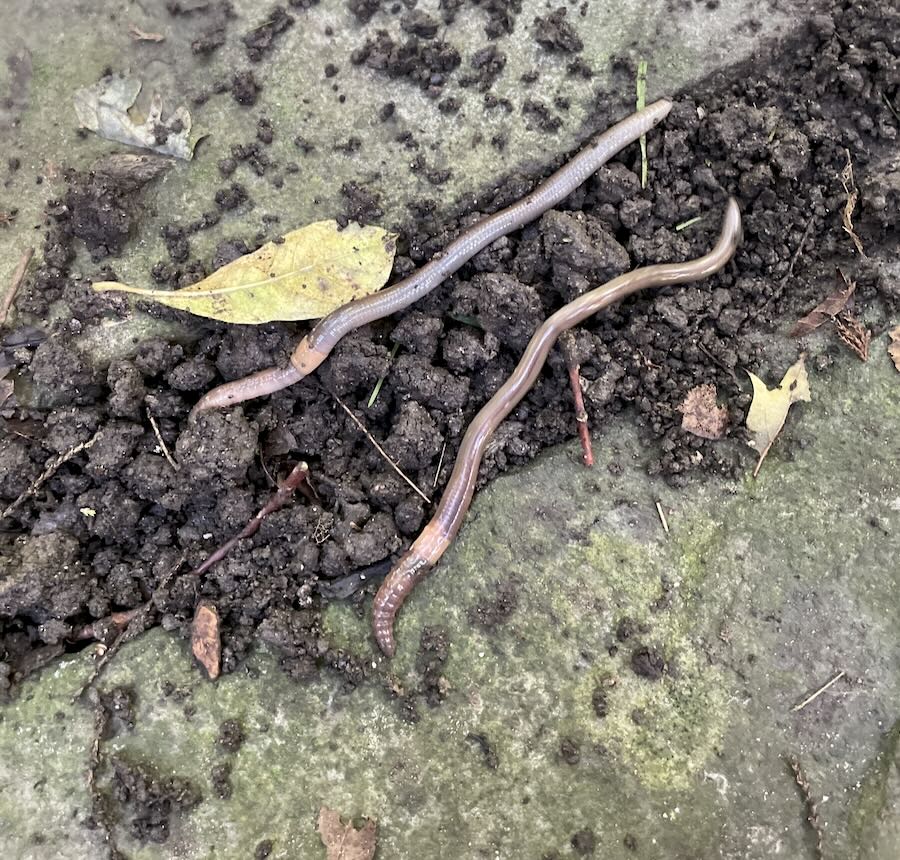
 Margaret: I positively am. And part of it, sadly, is because of, as soon as extra, of some of those changes in what was a well known … The soil was acquainted to me, the patterns of local weather have been additional acquainted to me. And I’ve been kind of reawakened, in a rude method [laughter], by these shifts.
Margaret: I positively am. And part of it, sadly, is because of, as soon as extra, of some of those changes in what was a well known … The soil was acquainted to me, the patterns of local weather have been additional acquainted to me. And I’ve been kind of reawakened, in a rude method [laughter], by these shifts.
And for me, as far as the soil and what’s worrying me about that, and I don’t know once you’ve received them there. The place I am and all by means of various … I really feel 38 states are affected now, parts of 38 states, I’ve the invasive leaping worms [above]. And they also degrade the soil so significantly. So having a model new mannequin of my outdated soil is … It’s like having to re-acclimate. So for me, that’s a selected scorching button correct now, and I’m attempting to actually really feel my method via it.
Tim: Yeah. This may be one in all many moments the place there is a stronger method for individuals who won’t already be soil obsessed, the place they arrive to understand how essential it is. I’m fully with you. I’m not pretty sure what the choices are, however, for leaping worms, nevertheless the idea our soils may very well be burning via their nutritional vitamins faster … We thought of these as a result of the repositories, the problems … I take into accounts the soil as a result of the issue that I’m investing in so that it could properly develop the vegetation that I want to develop. And since it changes, I almost actually really feel like I’ve purchased a member of the household who’s in need of help to attempt to gradual a sickness. And I’m not pretty sure what to do with that one however.
Margaret: No, nevertheless I really feel just like what I was talking about with the rain, merely masking our eyes, ears [laughter], and just like hear no evil, see no evil isn’t going to help. So watching and attempting to draw inferences, I really feel that … and clearly finding out the evaluation as a result of it’s printed and so forth, I really feel that’s going to be important. Feeling our method via.
And I really feel this attitude, this mindset that you just’re talking about, about being a bio-productive gardener, so in several phrases, desirous about every step, and desirous about every enter or every movement ahead of time. I really feel that kind of consciousness, I suggest hopefully that’s going to help us to find out these obstacles, of learn to address just a few of those obstacles the simplest method attainable, hopefully.
So the remaining about bio-productive gardening? The remainder that entails ideas? I suggest, I actually just like the considered … I hadn’t even thought of getting a non-petroleum oil for devices. I don’t use a chainsaw myself. Nevertheless for devices and stuff, using a cooking oil or a vegetable oil, kind of issue. So even that further quart that you just buy may very well be not petroleum-based.
Tim: Yeah. I really feel too, for me, embracing electrical moreover means a far more good environment after I’m using these devices. It’s-
Margaret: Boy, it’s quite a bit a lot much less loud, isn’t it?
Tim: Quite a bit a lot much less noise. You’re not producing exhaust fumes that you just’re inhaling. When you start them up and shut them off, it’s far more instantaneous. You don’t have that fastened revving engine. It does actually merely make even the administration of our landscapes rather more pleasurable.
I really feel the big issue, too, is I on a regular basis want to make it doable for gardeners and individuals who discover themselves exploring new points with probably the greatest intentions, that they actually really feel empowered to step into that space and that the aim is to not be glorious, it’s to easily be larger. And so there’s points that I’m doing and by no means doing now that 5 years previously felt O.Okay. to me. And I merely have a definite perspective, and it will proceed to shift. And that’s actually the big pleasure of gardening, is that we get to change with it, and it’ll get to change us.
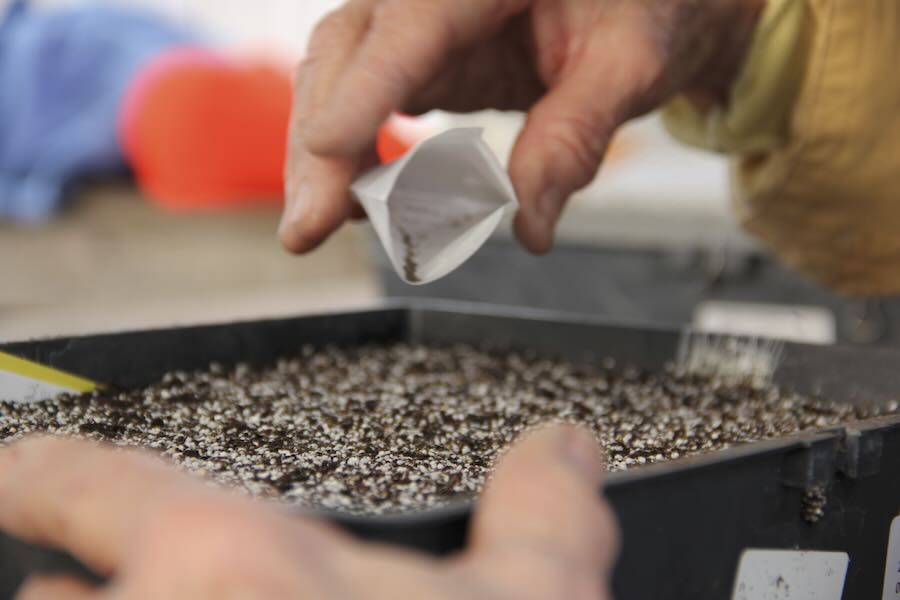
 Margaret: The remainder you want to inform us about in relation to that’s occurring that you just’re obsessed with at Native Plant Perception? I suggest, I’m obsessed with your native seed mission, and likewise you alluded to that sooner than. Nevertheless that’s one which I’m very involved about seeing how that goes. [Above, sowing seeds at Nasami Farm; photo by Jane Roy Brown for Native Plant Trust.]
Margaret: The remainder you want to inform us about in relation to that’s occurring that you just’re obsessed with at Native Plant Perception? I suggest, I’m obsessed with your native seed mission, and likewise you alluded to that sooner than. Nevertheless that’s one which I’m very involved about seeing how that goes. [Above, sowing seeds at Nasami Farm; photo by Jane Roy Brown for Native Plant Trust.]
Tim: Yeah. There’s masses to be obsessed with. Native Plant Perception, sooner than I joined the group, kind of despatched me on this journey of contemplating in any other case. I have in mind visiting Yard inside the Woods six years previously or so, and seeing their lawn-alternative and contemplating, “That is not at all going to catch on.” [Laughter.] And now proper right here I am attempting to find out learn to make it work in my very personal yard. And it was because of Plant Perception was to this point ahead of the curve.
I really feel that part of this bio-productive panorama implies that the vegetation in our gardens must be an extension of the genetics in our communities. And so the Northeast Seed Group is an effort to establish these reliable seed supplies of locally-adapted seed for usually grown vegetation. And to do it in a fashion that doesn’t suggest we’re at all times going once more to nature and taking seeds, because of we don’t want to actually disrupt these pure processes each. It’s an enormous mission. I really feel Nasami is a pilot actually of how this can be completed. And I might wish to see a Nasami in every state and every ecoregion all by means of New England, nevertheless we’ll should attend and see if we’re capable of make that happen.
Margaret: Successfully, Tim Johnson, from Native Plant Perception, congratulations as soon as extra on the model new place. And actually lot of thrilling stuff beneath method and further to return again, I assume. So I hope we’ll keep up a correspondence all by means of the season ahead, and thanks for making time in the meanwhile to talk.
Tim: I really respect it. Thanks, Margaret.
need the podcast mannequin of the current?
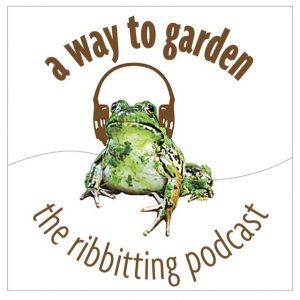
 MY WEEKLY public-radio current, rated a “top-5 yard podcast” by “The Guardian” newspaper inside the UK, began its fifteenth yr in March 2024. It’s produced at Robin Hood Radio, the smallest NPR station inside the nation. Hear regionally inside the Hudson Valley (NY)-Berkshires (MA)-Litchfield Hills (CT) Mondays at 8:30 AM Jap, rerun at 8:30 Saturdays. Or play the March 18, 2024 current using the participant near the very best of this transcript. You’ll subscribe to all future editions on iTunes/Apple Podcasts or Spotify (and browse my archive of podcasts proper right here).
MY WEEKLY public-radio current, rated a “top-5 yard podcast” by “The Guardian” newspaper inside the UK, began its fifteenth yr in March 2024. It’s produced at Robin Hood Radio, the smallest NPR station inside the nation. Hear regionally inside the Hudson Valley (NY)-Berkshires (MA)-Litchfield Hills (CT) Mondays at 8:30 AM Jap, rerun at 8:30 Saturdays. Or play the March 18, 2024 current using the participant near the very best of this transcript. You’ll subscribe to all future editions on iTunes/Apple Podcasts or Spotify (and browse my archive of podcasts proper right here).
[ad_2]
Provide hyperlink

